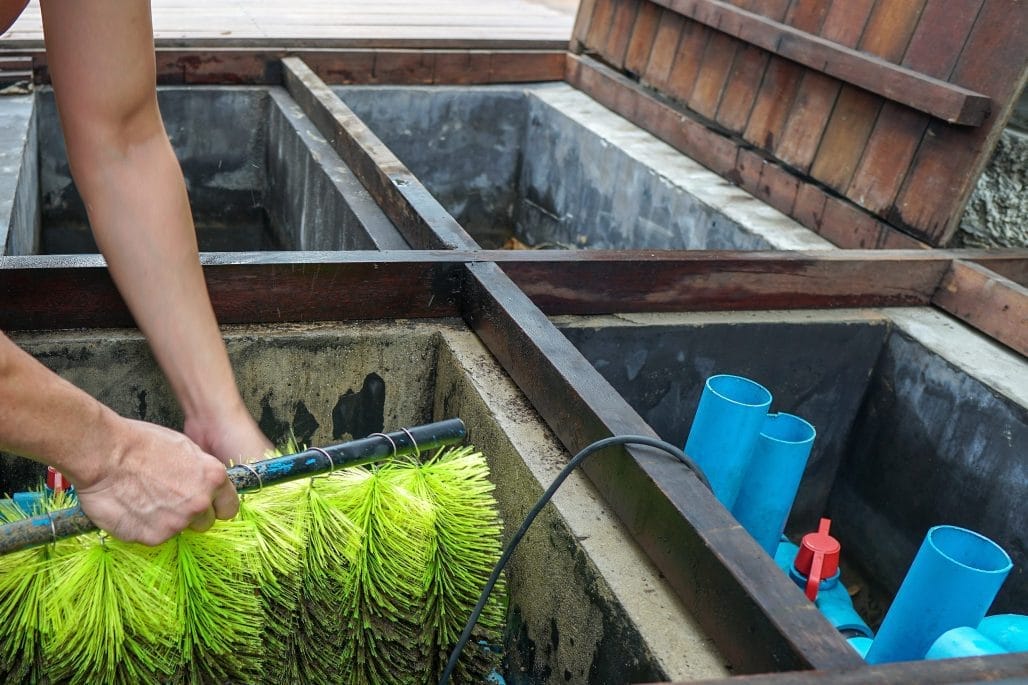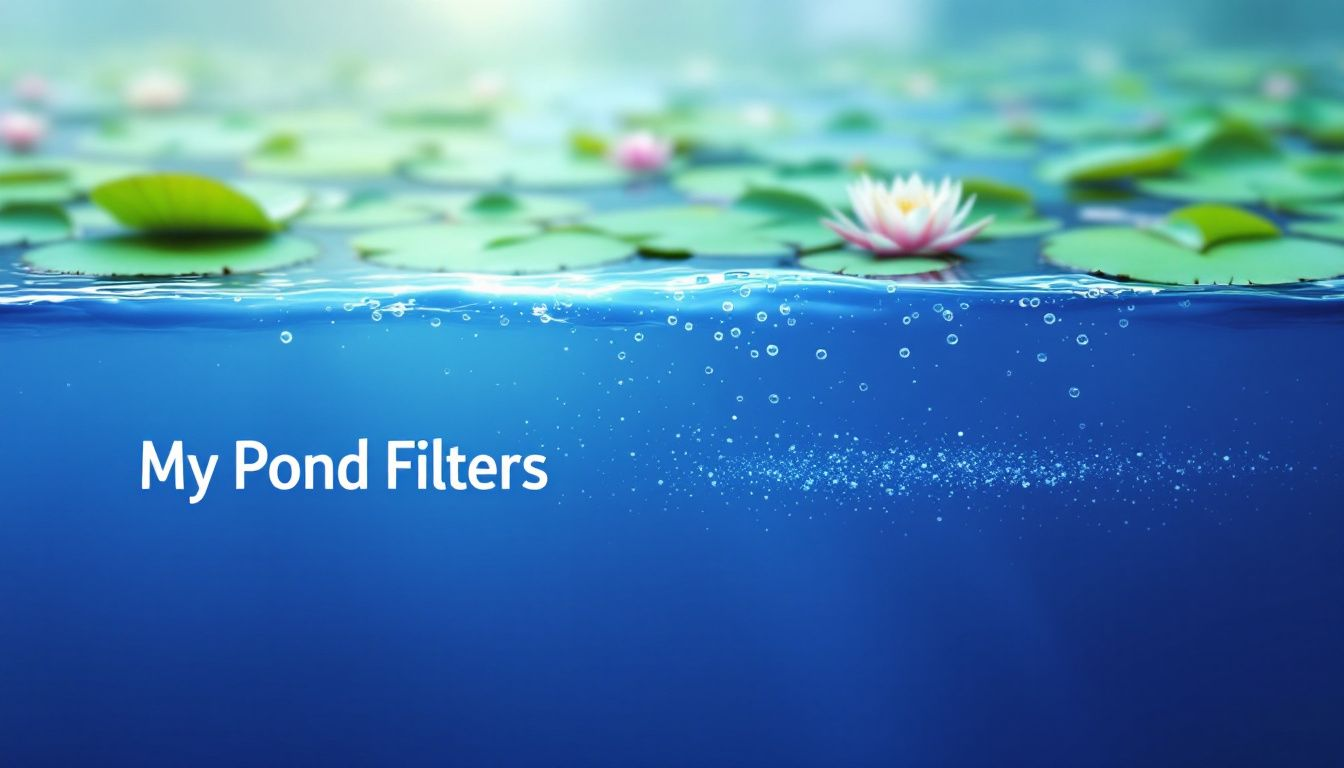The Ultimate Guide to Pond Biological Filtration



The Ultimate Guide to Pond Biological Filtration
Pond biological filtration is essential for maintaining a healthy pond ecosystem. Beneficial bacteria break down harmful compounds, converting them into less toxic substances that plants can use. This guide will explain how biological filtration works, different types of filters, and how to choose and maintain the right system for your pond.
Key Takeaways
- Biological filtration in ponds relies on beneficial bacteria to decompose organic waste and maintain water quality, requiring adequate surface area for bacterial growth.
- Different types of biological filters, such as submerged and trickle filters, each have unique advantages and suitability, making informed selection critical for pond health.
- Regular maintenance, including monitoring water quality, cleaning filter media with pond water, and integrating mechanical and UV filtration, is essential for a functional and efficient biological filtration system.
Understanding Biological Filtration

Biological filtration in ponds relies on beneficial bacteria to decompose organic waste, converting harmful compounds into less toxic substances that plants can utilize as nutrients. Think of a biological filter as a miniature sewage system. It uses filter media to create a large surface area, allowing beneficial bacteria to colonize and break down harmful toxins in the water, including those that biological pond filters target.
These bacteria play a critical role in controlling ammonia levels, which, if left unchecked, can be detrimental to aquatic life. Optimal biological filtration requires providing a significant surface area for these bacteria to thrive. This can be achieved with various filter media, rocks, and gravel. However, patience is key, as it takes time for these beneficial bacteria to develop and establish themselves in the filter media.
Understanding the natural process of biological filtration at a molecular level helps appreciate its importance in maintaining a healthy pond ecosystem. Mimicking nature helps create a balanced environment where fish and plants can flourish, resulting in clear water and vibrant pond life.
Types of Biological Filters
When it comes to biological filtration, there are two main types of biological filters that pond owners can choose from: submerged filters and trickle filters. Submerged filters are placed directly in the pond and require sufficient oxygen in the water to support bacterial growth effectively. On the other hand, trickle filters distribute water over media, enhancing aeration and promoting bacterial film growth.
Another innovative option is the moving-bed reactor, which incorporates floating media to create internal mixing, thus improving biofilm management. Expandable granular filters are versatile, functioning as biofilters, mechanical filters, or bioclarifiers depending on their settings. Coarse-sand fluidized beds, in particular, perform well under heavy loading conditions, supporting high conversions but requiring constant operation.
Each type of filter has its unique advantages and is suited to different pond setups. Understanding these options allows you to make an informed decision that best meets the needs of your pond’s ecosystem.
Choosing the Right Biological Filter for Your Pond

Choosing the right biological filter for your pond is crucial for maintaining a healthy pond ecosystem. For ponds with only a few fish or primarily plants, a filter rated for low fish stock is sufficient. However, ponds with high fish stocks or koi require larger filters to manage the increased waste effectively.
Sunlight exposure also plays a role in filter choice. More sunlight can lead to increased algae growth, necessitating a more robust filter. It’s advisable to select a filter that exceeds the minimum capacity for your pond volume to accommodate future fish growth. Continuous operation of the filter, especially during warmer months, ensures consistent water quality.
Considering these factors ensures your pond remains a healthy and balanced environment for its inhabitants. Whether you have a koi ponds, garden pond, or any other type, the right biological filter is essential for a naturally balanced pond.
Setting Up Your Biological Filtration System

Setting up your biological filtration system requires careful planning and execution. The recommended filter capacity for a pond is 150% of the pond’s water volume. However, over-filtering can lead to energy wastage and higher costs.
Begin by positioning the filter correctly and ensuring that all connections are secure. It can take weeks for the filter to become biologically active after setup or maintenance, so patience is essential. During this period, monitor water quality closely and avoid introducing too many fish.
Following these steps will help you create an efficient biological filtration system that supports a healthy pond ecosystem. Investing time and effort into the initial setup lays the foundation for long-term success.
Maintaining Biological Filters
Once your biological filtration system is up and running, maintaining it is crucial for ongoing success. The initial establishment of beneficial bacteria in a new biological filter can take up to six weeks. During this time, monitor water quality and limit feeding to avoid overwhelming the system.
Using quality bio-filtration media that maintains beneficial bacteria without frequent cleaning helps sustain a healthy aquarium ecosystem. Always use pond water for cleaning filter media, as tap water can harm the beneficial bacteria essential for filtration.
Regular cleaning of filter media should only occur when water flow is significantly slowed. Staggering the cleaning of filter media helps maintain a stable population of bacteria. Following these maintenance tips ensures your biological filter continues to operate effectively.
Enhancing Biological Filtration with UV Clarifiers

UV clarifiers are powerful tools for enhancing biological filtration. They utilize ultraviolet light to deactivate microorganisms, preventing their reproduction and controlling algae growth in ponds. This results in clearer and more aesthetically pleasing water.
While UV clarifiers are effective against free-floating algae, they do not eliminate algae that grows on pond surfaces. The effectiveness of a UV clarifier is influenced by its wattage, with larger ponds requiring higher wattage models to ensure adequate treatment.
Regular maintenance, such as replacing UV bulbs approximately every six months and cleaning the Quartz sleeve as needed, ensures the UV filter’s efficiency. Integrating UV clarifiers into your filtration system enhances water clarity and overall pond health.
Integrating Mechanical Filtration
Mechanical filtration plays a vital role in maintaining pond water quality by trapping debris. A pond skimmer and mechanical filters, such as foam pads or blocks, capture floating waste and prevent harmful substances from decomposing in the water.
The integration of mechanical filtration in pond filter pumps helps to keep larger particles, like leaves and twigs, from clogging the pump mechanism. Common types of mechanical filters include foam and brush filters, which are designed to trap various sizes of particles.
Regular cleaning of mechanical filter media ensures optimal performance and prevents clogging. Incorporating mechanical filtration enhances the overall effectiveness of your pond’s filtration system.
The Role of Aquatic Plants in Biological Filtration
Regular cleaning of mechanical filter media ensures optimal performance and prevents clogging. Incorporating mechanical filtration enhances the overall effectiveness of your pond’s filtration system.
Aquatic plants are crucial for maintaining a balanced pond ecosystem. They contribute to biological filtration by processing nitrates in anaerobic zones of the pond, converting them into nitrogen gas released into the atmosphere.
Integrating aquatic plants into the 264 system enhances water quality and promotes a thriving ecosystem. Emergent filters utilize a combination of air and water to maintain high oxygen levels for biofilm health.
Incorporating plants creates a natural filtration system that complements your biological and mechanical filters, ensuring a healthy and vibrant ecosystem pond environment while also helping to manage green water.
Tips for Running an Efficient Biological Filtration System
Running an efficient biological filtration system requires continuous operation, ideally 24/7, especially from March to October. To maintain effectiveness, pond water should be filtered at least once every 1 to 2 hours. This will ensure the filter continues to work properly.
Maintaining oxygen flow through the filter continuously is crucial, as the beneficial bacteria rely on oxygen to thrive and process waste effectively. Regularly inspecting the pump’s pre-filter ensures optimal water flow into the filtration system.
Conducting regular water tests is essential, as clear water does not necessarily indicate a healthy ecosystem. Using bacterial supplements can enhance the filter’s performance, particularly during initial setup or after cleaning. Following these tips ensures your biological filtration system operates at peak efficiency.
Troubleshooting Common Issues
Common issues in biological filtration systems include clogged pumps and inadequate media. Clogged pumps can often be cleared by removing the check valve and cleaning any debris from the volute cover.
Some types of bio-filtration media offer inadequate surface area for anaerobic bacteria, which is essential for completing the nitrogen cycle. Clogged filters and pumps can significantly impact the efficiency of biological filtration systems.
Regular inspection and maintenance help identify and resolve these issues promptly. Addressing common problems ensures your filtration system continues to operate effectively.
Summary
In conclusion, a well-maintained biological filtration system is essential for a healthy pond ecosystem. By understanding the types of filters, choosing the right one, and following best practices for setup and maintenance, you can create a balanced and thriving pond environment.
In conclusion, a well-maintained biological filtration system is essential for a healthy pond ecosystem. By understanding the types of filters, choosing the right one, and following best practices for setup and maintenance, you can create a balanced and thriving pond environment.
Frequently Asked Questions
How long does it take for a biological filter to become effective?
A biological filter typically takes up to six weeks to become effective as beneficial bacteria establish themselves. It is essential to monitor water quality and limit feeding during this period.
Can I use tap water to clean my filter media?
You should not use tap water to clean your filter media, as it can harm the beneficial bacteria essential for a healthy ecosystem. Instead, always opt for pond water to ensure their protection.
How often should I clean my mechanical filters?
It is advisable to clean mechanical filters regularly, particularly when you notice a significant reduction in water flow, to maintain optimal performance and prevent clogging.
Do UV clarifiers eliminate all types of algae?
UV clarifiers eliminate free-floating algae but are ineffective against algae that adhere to surfaces. Thus, they do not provide a complete solution for all algae types.
What should I consider when choosing a biological filter for my pond?
When choosing a biological filter for your pond, it is essential to consider the fish stock, sunlight exposure, and pond size, ensuring the filter exceeds the minimum capacity for your current and future needs. This will help maintain a healthy environment for your aquatic life.

Frequently Asked Questions
MY POND IS OVERGROWN.
MY POND IS LEAKING – WHAT CAN I DO?
WHY IS MY POND WATER GREEN?
Do I need to have my pumps running all the time?
Why Choose Us
Experience With years of experience in pond maintenance and cleaning, our team has the expertise to handle ponds of all sizes and complexities. We are dedicated to delivering high-quality services tailored to meet the unique needs of each customer.
Professionalism Our team consists of trained professionals who are passionate about pond care. We take pride in our work and strive to exceed our customers’ expectations with every service we provide.
Customized Solutions We understand that every pond is different, and we tailor our services to suit the specific requirements of each customer. Whether you have a small backyard pond or a larger water feature, we have the knowledge and resources to keep it in pristine condition.
Environmentally Friendly Practices We are committed to using eco-friendly products and methods in our pond cleaning services. Our goal is to promote sustainability and preserve the natural balance of your pond ecosystem.
Customer Satisfaction Your satisfaction is our top priority. We work closely with our customers to ensure that their pond maintenance needs are met with professionalism and care. We take the time to listen to your concerns and provide personalized recommendations to help you achieve the pond of your dreams.
Ready to schedule a pond cleaning service with us?
Contact Aqua Pond today to learn more about our services and to book an appointment.
Let us help you create a clean, healthy, and vibrant pond that you can enjoy for years. Thank you for considering Aqua Pond for your pond maintenance needs.
What our Customers Say...
